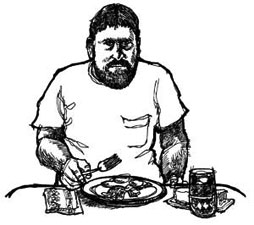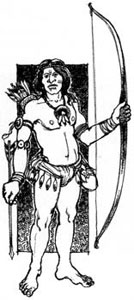

The Case for Intelligent Design
©Dean Torges/The Bowyer's Edge™
This article launched the Ambush Bow Challenge in 2006. The Challenge plans to be an annual event and the criteria will be refined for 2007. Consider its appearance here perspective for 2007 and a stimulus to your involvement. – Dean
 One of the several advantages classical bows have over their fiberglassed brothers is that you don't get locked into a building style because of a commitment to forms and jigs. You can make a bow any way you please, one upon the lessons of another, searching out improvements in any direction you wish to take, or one upon a whim, puzzling through problems in any direction the bow takes you. No two bows alike—not by accident or because of the inconsistencies and differences inherent in building materials, but by design.
One of the several advantages classical bows have over their fiberglassed brothers is that you don't get locked into a building style because of a commitment to forms and jigs. You can make a bow any way you please, one upon the lessons of another, searching out improvements in any direction you wish to take, or one upon a whim, puzzling through problems in any direction the bow takes you. No two bows alike—not by accident or because of the inconsistencies and differences inherent in building materials, but by design.
The freedom to explore bows is so important to advancing understanding, stimulating interest in our sport, and providing us personal satisfaction, that I based the choice of construction techniques and adjustable jigs featured in Hunting the Bamboo-Backed Bow upon flexibility and versatility. There's enough drudgery in our workplace without us bringing it to our hobby.
 I carried a selfbow last season and all of this season, hunting it hard. It's named Penelope after Odysseus' wife. She waited for him ten years following the Trojan War while he wandered from adventure to adventure. The bow is as straight as a plumb line in its relaxed profile, 64" nock to nock, and 60# at my 27" draw—an unadorned, straightforward selfbow, deceptively simple in appearance.
I carried a selfbow last season and all of this season, hunting it hard. It's named Penelope after Odysseus' wife. She waited for him ten years following the Trojan War while he wandered from adventure to adventure. The bow is as straight as a plumb line in its relaxed profile, 64" nock to nock, and 60# at my 27" draw—an unadorned, straightforward selfbow, deceptively simple in appearance.
Because it's sometimes braced for an average of ten hours a day for 6 or 7 days in succession, I lose an arrow spine class by the end of a hard week, which includes stump shooting to keep sharp, and don't get perfect flight without switching to a lighter spine. Quite simply, the wood fatigues from such a burden. Penelope stays faithful, but she gets tired waiting.
It's a common problem with the longbows and stylized Indian flatbows that most of us build. They're the perfect companion if you're wandering the swamp for pigs, the woodlot for squirrels, the mountains for elk, or the tundra for caribou. You can carry your bow unbraced until you anticipate action, weeks on end, without jeopardizing your chances or affecting the bow's performance. That's not an option stand-hunting whitetails hour upon hour, day following day unless you're comfortable losing occasional opportunities, perhaps even at Mr. X, because you didn't see or hear your quarry soon enough to brace up unnoticed.
I've been sorting out the path to a special bow, an ambush bow, a bow conceived and built specifically for tree-stand or ground-blind hunting—a bow to circumvent fatigue, one tailored to the situational demands this kind of hunting places upon it, at home for turkeys in Nebraska, whitetails in Connecticut, or impala in South Africa.
Here follows a list of the desirable qualities that would comprise such a bow, in no order of importance:
- It must be capable of staying braced for hours on end, day after hard hunting day, and not lose perceptible cast. The arrow you shoot in the early morning should strike the same mark in the late afternoon at a hunting distance.
- It must be quiet without the use of string silencers. Since most opportunities are close quarter at animals capable of eye-blink maneuvers, it shouldn't make more noise than a walnut hitting soft ground.
- It must be easily braced. Even if you're sitting or lying on the ground, you should be able to brace it effortlessly and positively with one throw, without the string slipping from the nock or the bow jumping from your hand.
- It must balance in the hand so it is quick to point of aim. Also, it must be short and maneuverable so you can bend into an awkward position and shoot from brushed-in tree stands or restrictive ground blinds without bouncing the bottom limb off platform cables, branches or the ground, or waving the top limb about like a semaphore flag.
- It must be forgiving. If you need to turn to one side on a tree stand platform and tuck the lower limb between your legs for clearance, for example, or cant the bow in some unusual position, the bow must not want to torque or twitch from such an awkward posture or the likelihood of a tortured release. In other words, the handle must provide for a repeatable grip and the limbs must be of a stable design.
- Even though it is short, no more than 58" nock to nock, it must be smooth to a 28" draw, so that no stacking hinders reaching full draw from any kind of awkward situation—cold, stiffness, or an unbalanced posture.
- It must pull at least 60 lbs at 28".
- It must shoot a heavy arrow, in excess of ten grains per pound of draw weight, and at 15 yards strike pretty much where a considerably lighter arrow does.
- It must be of dependable materials and of a reliable construction, as simple as its pursuit allows.
- It must be pleasurable to shoot. No kick, no shock to the nervous system, nothing unorthodox to the shooting style.
Is a bow built to this template possible? I've built short self bows and short backed and laminated bows, some that bent through the handle and some that didn't, but for one reason or another their faults detracted from their advantages. Still, I keep wondering: can a bow be built that includes these ten qualities, an ambush bow that achieves the ideal, that "has it all"?
Through The Bowyer's Journal™, I'm proposing a formal quest for such a bow, a contest for any bowyer interested in attempting one for the 2006 hunting season.
Here's the setup: Build your version of this bow, of organic materials (excepting glue, finish and string), and send The Bowyer's Journal™ a full description of it, with revealing photographs, by June 15, 2006.
While you're at it, why not include a subscription or a renewal to the magazine for yourself or as a gift for a friend? Of course, it's not a requirement, it won't sway the outcome, but it will save you double postage.
Be prepared to mail your bow and three compatible arrows by August 1, 2006, if The Bowyer's Journal™ judges request hands-on inspection of your entry.
Bows will be graded on a scale of 1 to 5 for each of the ten criteria, with a score of 50 representing perfect attainment. (Download the evaluation form - 64k PDF.) Best score wins an early-October 5-day squirrel and/or deer hunt in Southern Ohio, on 500 acres of private property. Winner is responsible for transportation to Athens or Port CMH, Columbus, Ohio, whichever is more convenient, The Bowyer's Journal™ to pick up the balance of expenses, including license fees.
This is a quality hunt, based from a fully equipped two-bedroom cabin, surrounded by posted property, not too far from where the new state record whitetail was taken in 2005. An adjacent 500 acres have been under an intense QDM program for ten years.
Runner-up wins a $250 dollar gift certificate to any merchant who advertises in The Bowyer's Journal™.
Third place Honorable Mention earns a free subscription to The Bowyer's Journal™ for three years.
The contest is open to everyone, professional or amateur, except for its judges.
The obligation of the contest winner is to write an article for The Bowyer's Journal™ detailing the bow's construction and design and the decision-making process behind it, as well as a brief evaluation of the bow's performance during its Southern Ohio adventure.
We use bows differently than our immediate predecessors. Our emphasis is less upon English longbows and rounds of competitive field archery at distant butts, and more upon rendezvous which feature close range 3-D targets that simulate hunting situations. We've become less field archer and more hunting archer, less soldier and more Indian. The need for an ambush bow to suit the changed circumstances of our sport is apparent, yet the 64" bows we carry to stand don't differ much in length and style from what they carried afield.
Here's an opportunity to focus talent, experience, effort and understanding to the purpose of tailoring a bow to specific needs, a universal ambush bow. And here's an invitation to its attempt for one and all.
"Carve a little wood, pull a few strings, and sometimes magic happens." — Gepetto
Addendum to Ambush Bow Challenge
In the interests of fair competition and shared, useful information, we're dividing the entries into classes of bows. There will still be only one champion, but it will come from one of three categories: the Self Bow Class, the Laminated/Backed Bow Class, or the Composite Bow Class.
Briefly, a self bow is defined as any bow made from one integral material, such as wood or bamboo. There are no glue joints along the length of the limbs. However splices to billets, riser additions outside the working portion of the limb, patches to faults anywhere along the limb, and horn nocks are permissible.
A laminated or backed bow includes any number of wood or bamboo laminations or sinew or wood backings, not to exceed two disparate organic materials. Typically, a bamboo backed bow, or a sinew or hickory backed bow, or a bow of many wooden laminations would fit into this category.
A composite bow has three disparate building materials comprising the makeup of its working limbs. The classic Turkish bow, of horn belly, wood core and sinew backing is the classic composite bow. However, a wooden bow sinew backed with a belly of baleen qualifies as a composite bow, as does a sinewed bow with a bamboo belly.
There will be a Best of Class for each of these three, and the Grand Champion will be chosen from them.
Criterion #5, ABC
5. "In other words, the handle must provide for a repeatable grip ...."
I regret the choice of "repeatable grip" in criterion #5, and saw its potential for misunderstanding almost from the time the challenge went public.
There was no intention to prescribe the kind of grip with a palm swell found on modern bows that locate your hand and determine how you hold the bow. The context, I hope, reveals that the handle must provide some means or suggestion by which the bow can be shot from its dynamic fulcrum time after time. In other words, I'm making here a distinction between where you hold the bow as opposed to how you hold it. For example, a broomstick shape for the length of the handle section that could be gripped anywhere along its length would not meet this criterion. It's the "where" that matters, not the "how."
Sorry if I sent someone down a road reluctantly traveled.
